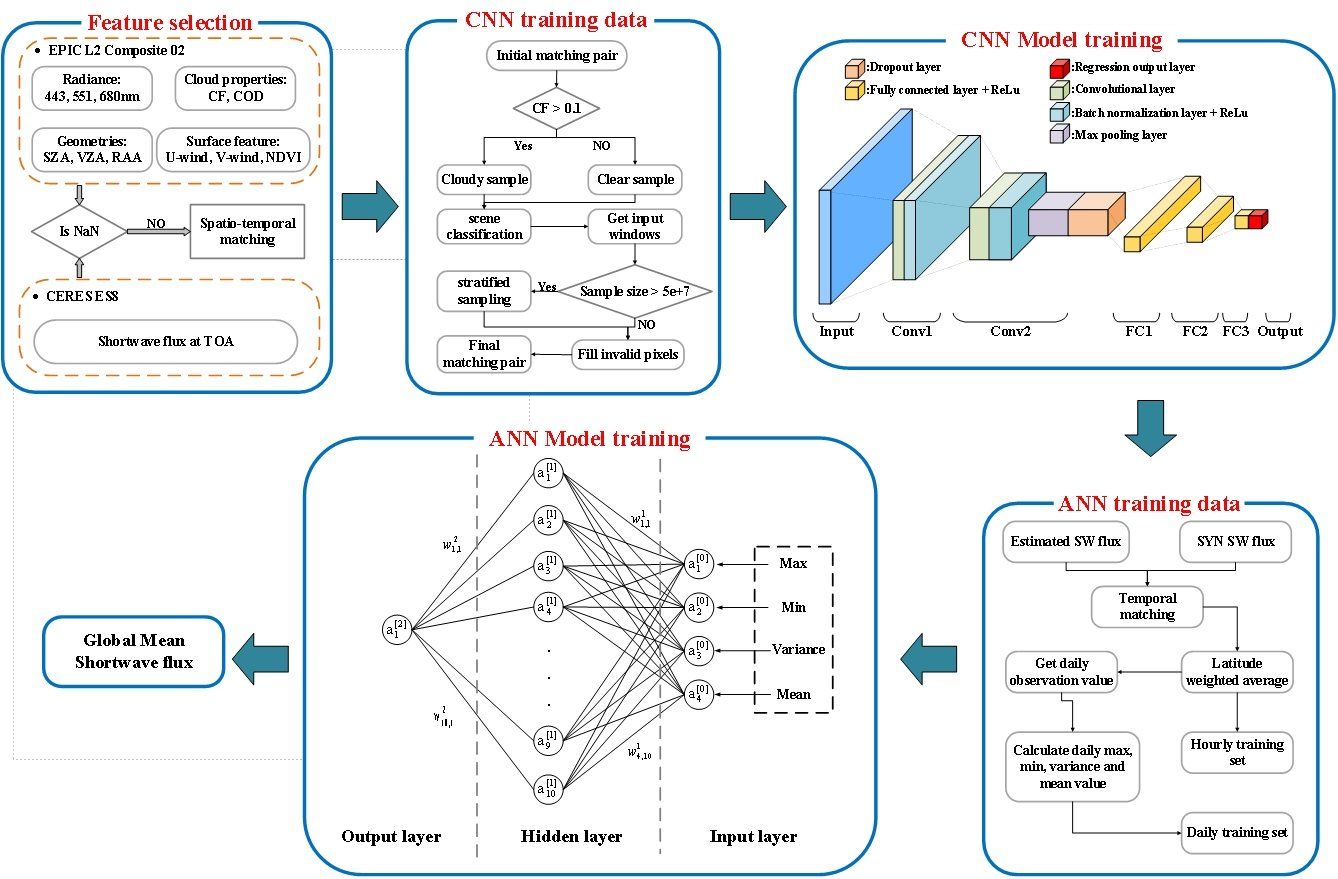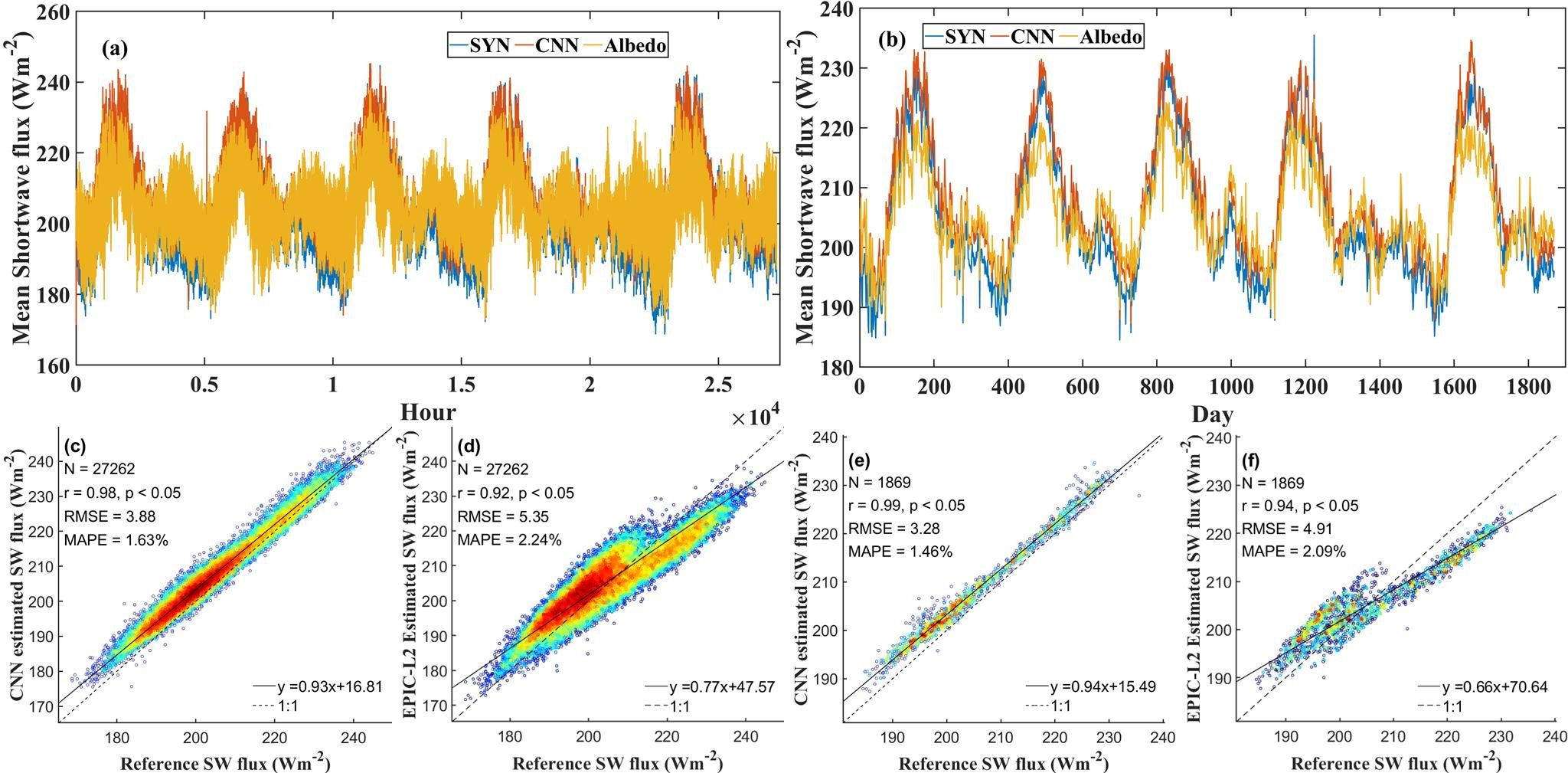On October 14, 2025, Liu Huizeng's group published a research paper entitled "A Deep Learning-based Framework for Estimating the Earth’s TOA Shortwave Radiation Flux from DSCOVR EPIC" in the JCR Q1 journal IEEE Transactions on Geoscience and Remote Sensing. The first author is Tianye Cao, a master's student at Shenzhen University. Huizeng Liu is the corresponding author. The Institute for Advanced Study at Shenzhen University is the primary affiliation. Co-authors include Academician Li Qingquan and Prof. Zhu Ping from Shenzhen University.
The Earth's top-of-atmosphere (TOA) radiation flux is a key component of the Earth's Radiation Budget (ERB). Accurate observation and estimation of TOA flux are crucial for understanding global warming, climate change, and extreme weather events. Deep space-based Earth observation, particularly from the DSCOVR/Earth Polychromatic Imaging Camera (EPIC) located at the Sun-Earth Lagrange point 1 (L1), offers a promising new perspective by providing continuous, full-disk observations of the sunlit Earth.
However, converting sensor-measured radiance into TOA flux requires accurate angular distribution models (ADMs). Currently, there are no ADMs specifically intended for DSCOVR/EPIC. Applying ADMs from other low-Earth-orbit satellites (like CERES) introduces significant uncertainties, which has been a key bottleneck limiting the application of L1-point observations in ERB studies.
To address this challenge, the research group developed an innovative deep learning-based framework. This framework combines convolutional neural networks (CNNs) and a multilayer perception neural network (MLPNN). First, a total of 18 CNN models were developed (for nine scene types under both cloudy and clear-sky conditions) and trained using synchronous matchups of DSCOVR/EPIC observations and CERES SSF products. This achieves a high-precision retrieval of TOA shortwave flux directly from EPIC multispectral images. Second, an MLPNN model was developed to relate the EPIC-derived flux to the global TOA shortwave flux from CERES SYN products, exploring the potential of L1 observations to represent the global flux.

Fig. 1. The proposed framework for estimating the TOA shortwave flux from DSCOVR/EPIC
Results showed that the TOA shortwave flux estimated by the deep learning framework was in excellent agreement with CERES SSF products and "obviously outperformed" the official EPIC-L2 albedo-derived product. More importantly, the study found that the DSCOVR/EPIC-derived flux, using this framework, could account for 93% of the variations in the global-mean shortwave flux at a daily scale. This study not only resolves the critical issue of lacking dedicated ADMs for DSCOVR/EPIC data but also, for the first time, quantitatively reveals the significant potential of Sun-Earth L1-point observations for monitoring the global Earth's Radiation Budget. The proposed framework is adaptable and could also serve as a valuable reference for ERB studies from other deep-space Earth observation missions, such as Moon-based platforms.

Fig. 2. Time-series variations of the global mean shortwave flux from the CERES SYN, CNN models and EPIC-L2 albedo within the EPIC’s field-of-view at instantaneous scale (a) and daily scale (b). Scatterplots of the mean shortwave flux within the EPIC's filed-of-view from CNN models (c) and EPIC-L2 albedo (d) against the CERES SYN at the instantaneous scale, and plot (e) and (f) are for CNN models and EPIC-L2 albedo data at the daily scale.
This work was supported in part by the National Natural Science Foundation of China, Guangdong Basic and Applied Basic Research Foundation, Shenzhen Science and Technology Program, Guangdong Major Project of Basic and Applied Basic Research, Shenzhen Municipal Government Investment Project, the Fengyun Application Pioneering Project, and the Scientific Foundation for Youth Scholars of Shenzhen University.
The research findings are published in:
Tianye Cao, Huizeng Liu*, Qingquan Li, Ping Zhu, Yuchen Zhao, Yan Ma, Lule Zhu, and Tianxing Wang, "A Deep Learning-Based Framework for Estimating the Earth's TOA Shortwave Radiation Flux From DSCOVR EPIC". IEEE Transactions on Geoscience and Remote Sensing, vol. 63, 2025, pp. 1-14, Art no. 4708114. https://doi.org/10.1109/TGRS.2025.3621118


